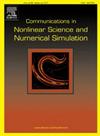保护区在水生物种持续存在中的作用:一个渔业管理的反应-扩散-平流模型
IF 3.8
2区 数学
Q1 MATHEMATICS, APPLIED
Communications in Nonlinear Science and Numerical Simulation
Pub Date : 2025-07-21
DOI:10.1016/j.cnsns.2025.109147
引用次数: 0
摘要
为了确保渔业资源的可持续利用,保护濒危水生物种,建立水生保护区是必不可少的。本文提出了一个带保护区的反应-扩散-平流模型,该模型描述了局部无采集区河流中的单物种种群。我们研究了三种不同情景下种群的持续和灭绝:强流动、强扩散和弱扩散。结果表明,在强流或弱扩散情景下,如果下游河流环境封闭,则在任何收获强度下,只有边界-下游保护区才能使种群存活。在强扩散情况下,无论保护区有多长,在哪里,恶劣的边界条件总是使种群面临灭绝的危险。在一般边界条件下,对于满足logistic或弱狭缝生长的种群,导出了最优保护区,即内部保护区、边界-上游保护区和边界-下游保护区的临界长度。最后,数值模拟结果表明,考虑平流动力学因素可以导致保护区空间位置与物种生存阈值之间的复杂关系,而保护区长度的影响则表现为直接的单调趋势。研究结果可为水产保护区的合理设计提供有价值的见解,有助于更有效的渔业管理和水生物种的长期保护。本文章由计算机程序翻译,如有差异,请以英文原文为准。
The role of protection zones in the persistence of aquatic species: A reaction–diffusion–advection model for fishery management
To ensure the sustainable use of fisheries resources and preserve endangered aquatic species, the establishment of aquatic protection zones is essential. In this paper, we propose a reaction–diffusion–advection model with a protection zone, which describes a single-species population in rivers with a local no-harvesting zone. We investigate the persistence and extinction of populations under three different scenarios: strong-flow, strong-diffusion, and weak-diffusion. It turns out that in strong-flow or weak-diffusion scenarios, if the downstream river environment is closed, then only the boundary-downstream protection zone enables the population to survive under any harvesting intensity. In strong-diffusion scenarios, hostile boundary conditions always put the population at risk of extinction, irrespective of how long and where the protection zone is. Furthermore, for populations satisfying logistic or weak Allee growth in homogeneous environments with general boundary conditions, we derive the optimal protection zones, namely, the critical lengths of the internal protection zone, the boundary-upstream protection zone, and the boundary-downstream protection zone. Finally, numerical simulations show that incorporating advection dynamics can lead to a complex relationship between the spatial location of protection zones and species survival thresholds, whereas the influence of protection zone length exhibits a straightforward monotonic trend. These results may provide valuable insights for the rational design of aquatic protection zones, which can contribute to more effective fisheries management and the long-term conservation of aquatic species.
求助全文
通过发布文献求助,成功后即可免费获取论文全文。
去求助
来源期刊

Communications in Nonlinear Science and Numerical Simulation
MATHEMATICS, APPLIED-MATHEMATICS, INTERDISCIPLINARY APPLICATIONS
CiteScore
6.80
自引率
7.70%
发文量
378
审稿时长
78 days
期刊介绍:
The journal publishes original research findings on experimental observation, mathematical modeling, theoretical analysis and numerical simulation, for more accurate description, better prediction or novel application, of nonlinear phenomena in science and engineering. It offers a venue for researchers to make rapid exchange of ideas and techniques in nonlinear science and complexity.
The submission of manuscripts with cross-disciplinary approaches in nonlinear science and complexity is particularly encouraged.
Topics of interest:
Nonlinear differential or delay equations, Lie group analysis and asymptotic methods, Discontinuous systems, Fractals, Fractional calculus and dynamics, Nonlinear effects in quantum mechanics, Nonlinear stochastic processes, Experimental nonlinear science, Time-series and signal analysis, Computational methods and simulations in nonlinear science and engineering, Control of dynamical systems, Synchronization, Lyapunov analysis, High-dimensional chaos and turbulence, Chaos in Hamiltonian systems, Integrable systems and solitons, Collective behavior in many-body systems, Biological physics and networks, Nonlinear mechanical systems, Complex systems and complexity.
No length limitation for contributions is set, but only concisely written manuscripts are published. Brief papers are published on the basis of Rapid Communications. Discussions of previously published papers are welcome.
 求助内容:
求助内容: 应助结果提醒方式:
应助结果提醒方式:


